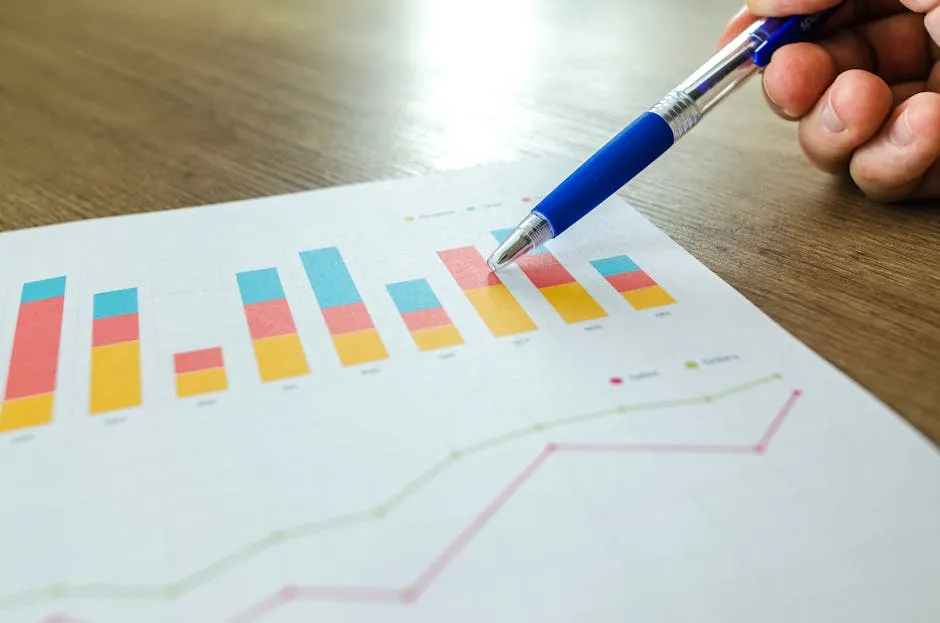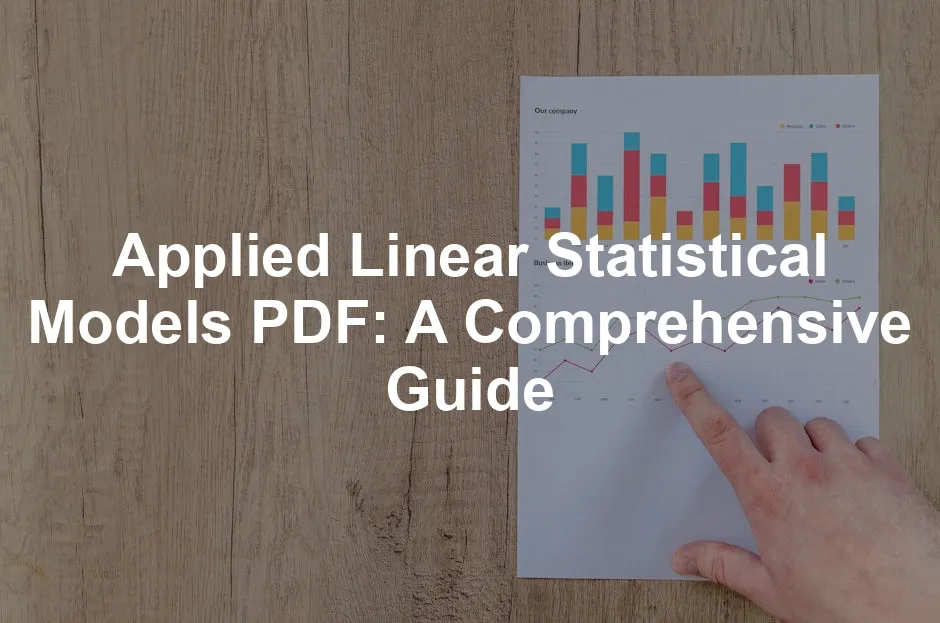Introduction
Applied linear statistical models are essential tools in various fields. Whether you’re in economics, engineering, or social sciences, they help make sense of complex data. These models allow researchers and professionals to understand relationships between variables and make predictions. Imagine trying to forecast sales based on advertising spending. A solid linear model can be your crystal ball!
The “Applied Linear Statistical Models” PDF is a treasure trove of information. Authored by experts like Michael Kutner and Christopher Nachtsheim, this document is invaluable for students, researchers, and anyone keen on mastering statistical analysis. It offers a detailed exploration of linear models, blending theory and practical applications seamlessly. If you’re looking to dive deeper into applied statistics, you might want to grab a copy of Applied Linear Statistical Models by Michael H. Kutner.
In this article, we’ll summarize the PDF’s content. Expect to uncover major themes, key concepts, and practical applications that can enhance your understanding of linear statistical models. Are you ready to demystify the world of statistics? Buckle up!

Understanding Applied Linear Statistical Models
What Are Linear Statistical Models?
Linear statistical models serve a pivotal role in data analysis. At their core, these models help describe the relationship between variables through linear equations. Think of them as the bridge connecting your raw data to actionable insights.
There are several types of linear models. The simplest is the simple linear regression, which examines the relationship between two variables. Picture a straight line on a scatter plot—this represents the relationship between, say, hours studied and test scores. To enhance your knowledge, consider checking out Statistics for Dummies by Deborah J. Rumsey.
Next up is the multiple linear regression. This model extends the concept by incorporating multiple predictors. Now, you can factor in various elements—like study time, class attendance, and previous grades—to predict that elusive test score.
Lastly, we have polynomial regression. Sometimes, relationships aren’t linear. Polynomial models allow for curves, capturing more complex relationships. Imagine trying to fit a roller coaster track to your data points—sometimes, a straight line just won’t cut it! Speaking of curves, if you’re interested in understanding more about data visualization, Data Visualization: A Practical Introduction by Kieran Healy will be a great addition to your library.
These models are not just academic exercises; they have real-world applications. From predicting market trends to evaluating experimental results, linear statistical models are indispensable. So, whether you’re crunching numbers for a thesis or analyzing data for a business report, understanding these models is crucial.
For more insights on statistical models, check out generative ai models are statistical models true or false.
With this foundation, you’re well on your way to grasping the full potential of the “Applied Linear Statistical Models” PDF. Next, let’s dive deeper into its contents, revealing the insights that await!

Importance of Statistical Models in Data Analysis
Statistical models are the secret sauce in data analysis. They help in making predictions and understanding relationships between variables. Imagine trying to forecast your favorite sports team’s performance without some solid data. It’s like throwing darts in the dark!
Let’s consider a few real-world scenarios. Businesses often use statistical models to predict sales based on various factors. For example, a company might analyze how advertising spending influences sales. Without these models, they’d be guessing at best. To get a deeper understanding of data-driven decisions, Data Science for Business by Foster Provost is a great resource.
In scientific research, statistical models shine brightly as well. Take experimental data analysis. Researchers utilize these models to assess the impact of different treatments on outcomes. It’s all about drawing meaningful conclusions from the noise of raw data.
So, whether you’re in marketing, healthcare, or even sports, statistical models are indispensable for making informed decisions!
Overview of the “Applied Linear Statistical Models” PDF
Metadata and Key Details
The “Applied Linear Statistical Models” PDF is a goldmine for anyone diving into statistics. Authored by a formidable team—Michael H. Kutner, Christopher J. Nachtsheim, John Neter, and William Li—this resource is essential for students and professionals alike. To complement this, consider picking up R for Data Science by Hadley Wickham.
– ISBN: 0-07-238688-6
Publication Year: 2004
File Size: Approximately 50MB
This PDF is structured into clear chapters and sections, allowing readers to navigate easily. Each part is crafted to build on the previous concepts, ensuring a comprehensive understanding of applied linear statistical models.

Content Breakdown
Part One: Simple Linear Regression
This section is a treasure trove for anyone wanting to grasp the basics of linear regression. It starts with chapters dedicated to simple linear regression, focusing on key concepts and methods that are crucial for beginners.
The first chapter introduces linear regression with one predictor variable. Topics include:
- Relations between Variables: Understanding how one variable influences another.
- Regression Models and Their Uses: Applying these models to real-world scenarios.
- Inferences Concerning Parameters: Learning to make educated guesses based on data.
- Data for Regression Analysis: Gathering and preparing data for effective analysis.
Next, readers encounter diagnostics and inferences. This segment emphasizes the importance of understanding how well the model fits the data. It also covers essential topics like:
- Estimating Error Terms Variance: A critical step for assessing model accuracy.
- Prediction of New Observations: How to use the model to make future forecasts.
Finally, the section wraps up with a discussion on diagnostics. This part guides readers through assessing the model’s adequacy, ensuring they can identify potential pitfalls. If you’re interested in a broader understanding of data analysis, consider Python for Data Analysis by Wes McKinney.
With this foundational knowledge, readers will be well-equipped to tackle the complexities of statistical analysis. The “Applied Linear Statistical Models” PDF serves not just as a textbook but as a reliable companion in their statistical endeavors.

Part Two: Multiple Linear Regression
Multiple regression analysis is a powerful statistical tool. It enables researchers to analyze relationships among multiple variables. Have you ever wondered how various factors come together to influence an outcome? For instance, predicting a student’s test score isn’t just about study hours. You must consider attendance, past grades, and even the coffee consumption level!
This method is significant for handling complex datasets. It allows you to build models that reflect reality more accurately. Instead of focusing on a single predictor, multiple regression embraces the chaos of real-world data. The insights gained can steer decisions in education, finance, healthcare, and beyond. For a comprehensive guide on statistical learning, check out The Elements of Statistical Learning by Trevor Hastie.
Key chapters in this PDF include crucial topics like multicollinearity and analysis of variance. Multicollinearity occurs when predictors are highly correlated. This can inflate variance and make estimates unreliable. Understanding this phenomenon helps in refining models, ensuring that each predictor contributes unique information.
The analysis of variance (ANOVA) is another critical aspect. It assesses the significance of the predictors collectively. Think of it as a referee in a sports match, determining if the players (predictors) are truly impacting the score (outcome). ANOVA helps in evaluating how much of the outcome’s variation can be explained by the model.
Now let’s peek into the additional sections of the PDF. The appendices are treasure maps, filled with exercises that let you practice what you’ve learned. These exercises challenge your understanding and enhance your skills. Case studies provide real-world applications, showcasing how multiple linear regression solves actual problems.
Lastly, don’t skip the references! They guide you to further reading, deepening your mastery of the subject. With these resources, you can confidently navigate the complexities of multiple regression analysis. It’s an adventure worth embarking on!

Regression Techniques and Methods
Overview of Regression Analysis Steps
Performing regression analysis is like baking a cake. You need the right ingredients, a solid recipe, and a bit of patience. Here’s a step-by-step guide to help you navigate through the process.
- Data Preparation: Start by gathering your data. Ensure it’s clean and organized. Missing values can be troublesome, much like forgetting to add sugar to your cake!
- Exploratory Data Analysis (EDA): Before jumping into modeling, explore your data. Use visualizations like scatter plots to understand relationships between variables. This step is crucial; think of it as preheating your oven.
- Model Selection: Choose the right regression model based on your data type and research question. Simple linear regression works for one predictor, while multiple regression is ideal for several. It’s like choosing between a sponge and a chocolate cake recipe!
- Model Fitting: This step involves applying the chosen regression technique to your data. Use statistical software to fit the model. Think of this as mixing your ingredients until smooth.
- Diagnostics: Once your model is fitted, check its performance. Analyze residuals to ensure they’re randomly distributed. This is akin to checking if your cake has risen evenly.
- Interpretation of Results: Finally, interpret the coefficients and p-values. Explain what they mean in practical terms. This is where you slice and serve your cake, sharing the delicious results with everyone!

Advanced Topics
As you become more comfortable with regression, it’s time to tackle advanced concepts. Let’s spice things up! If you’re interested in diving deeper into advanced statistical methods, consider Bayesian Data Analysis by Andrew Gelman.
- Logistic Regression: This is a go-to method when your outcome variable is binary. For instance, predicting whether a patient has a disease (yes or no) based on various predictors. It’s like deciding if you should order pizza or sushi for dinner—there are two clear options!
- Generalized Linear Models (GLMs): These models extend traditional regression techniques. They allow for response variables that follow different distributions—think Poisson for count data or binomial for proportions. GLMs are versatile, making them suitable for various fields, from healthcare to marketing.
- Applications in Various Fields:
- Healthcare: Logistic regression is often used to predict patient outcomes.
- Marketing: Businesses utilize GLMs to forecast customer behavior based on survey data.
- Environmental Studies: Researchers apply these models to assess the impact of climate variables on species survival.
Understanding these advanced techniques can elevate your analysis game. It’s like upgrading from a basic cake recipe to a multi-layered masterpiece! And if you’re curious about a practical guide to data science, The Data Science Handbook could be the perfect fit.

Practical Applications and Case Studies
Real-World Applications of Linear Statistical Models
Linear statistical models have a profound impact across various sectors. Let’s take a closer look at how they are applied in real life.
- Healthcare: In medicine, linear models are used to predict patient outcomes based on different risk factors. For instance, a study might analyze how age, weight, and exercise levels affect heart disease risk. By modeling these relationships, healthcare professionals can identify high-risk patients and intervene early.
- Marketing: Businesses rely on linear models to predict sales based on advertising expenditure. By analyzing past data, companies can forecast how much additional revenue a new marketing campaign might generate. Imagine a small startup using linear regression to determine the optimal budget for social media ads!
- Environmental Studies: Researchers use these models to understand how environmental factors influence species populations. For example, scientists might assess how temperature and rainfall affect crop yields. This data-driven approach can inform agricultural practices, helping farmers optimize their harvest.
- Finance: In finance, linear models assist in risk assessment and portfolio management. Analysts can predict stock prices based on historical data and economic indicators. It’s like navigating a ship; accurate predictions help steer clear of financial storms!
- Education: Linear statistical models are utilized to evaluate student performance. By analyzing data such as attendance, homework completion, and test scores, educators can identify factors that contribute to academic success. This insight can lead to targeted interventions for struggling students.
These examples highlight the versatility and importance of linear statistical models. From predicting health outcomes to enhancing business strategies, they are invaluable tools for making informed decisions. It’s clear that understanding these models can empower individuals and organizations alike!

Case Studies from the PDF
The “Applied Linear Statistical Models” PDF is replete with fascinating case studies that illustrate the practical application of linear statistical models. Let’s highlight a few standout examples that shed light on how these models work in real-world scenarios.
One case study focuses on predicting student performance in higher education. Researchers utilized multiple linear regression to analyze factors such as study habits, attendance, and prior academic achievements. By applying this model, they found that attendance and consistent study habits significantly impacted students’ final grades. This insight allows educators to tailor their support to improve student outcomes.
Another intriguing example involves a marketing analysis. In this case, businesses sought to understand how advertising spending affects sales. By employing simple linear regression, they could quantify the relationship between their ad budgets and sales figures. The model revealed that an increase in advertising expenditures led to a notable rise in sales, allowing companies to allocate their budgets more efficiently. If you’re keen to explore more about marketing analytics, Discovering Statistics Using IBM SPSS Statistics by Andy Field is a fantastic resource.
In the healthcare sector, a study explored the relationship between patient demographics and recovery times after surgery. Using multiple linear regression, researchers assessed variables like age, weight, and pre-existing conditions. Their findings indicated that younger patients with fewer health issues had shorter recovery periods. This valuable information can guide healthcare providers in developing tailored post-operative care plans.
Lastly, let’s not forget the environmental case study that analyzed the impact of climate change on crop yields. Researchers used polynomial regression to model the nonlinear relationship between temperature fluctuations and agricultural output. The model highlighted critical temperature thresholds beyond which crop yields significantly declined. This research is essential for farmers and policymakers in addressing food security amid changing climate conditions.
These case studies from the PDF exemplify how applied linear statistical models can provide actionable insights across various fields. They not only demonstrate the versatility of these models but also emphasize the importance of data-driven decision-making in everyday scenarios.

Conclusion
Understanding and utilizing applied linear statistical models is invaluable for data analysis in diverse fields. The “Applied Linear Statistical Models” PDF serves as a comprehensive resource, bridging theoretical concepts and practical applications. We explored various topics, from simple and multiple linear regression to advanced techniques like logistic regression and generalized linear models.
The key takeaway? Linear statistical models empower us to make informed predictions and understand relationships between variables. Whether you’re in marketing, healthcare, or environmental science, these models help you navigate the complexities of data analysis.
Furthermore, the case studies we discussed illustrate the real-world impact of these models. They provide concrete examples of how statistical analysis can lead to better decision-making and improved outcomes across various sectors.
For those eager to dive deeper into the subject, we encourage you to refer to the “Applied Linear Statistical Models” PDF. It’s not just a textbook; it’s a treasure trove of knowledge waiting to be explored. By engaging with this resource, you can enhance your understanding of linear statistical models and their applications, ensuring that you stay ahead in the ever-evolving field of data analysis. And for a broader perspective, consider The Art of Statistics: Learning from Data by David Spiegelhalter.

FAQs
What is the difference between simple and multiple linear regression?
Simple linear regression analyzes the relationship between two variables. It uses a single predictor (independent variable) to explain changes in a response (dependent variable). For instance, you might want to predict a student’s test score based on hours studied. The relationship is represented by a straight line on a graph, showing the trend. Multiple linear regression, on the other hand, involves two or more predictors. For example, you could predict a student’s test score based on study hours, class attendance, and previous grades. This model captures the combined effect of multiple factors, allowing for more nuanced predictions.
How can I apply linear statistical models in my research?
Applying linear statistical models in research involves several steps: 1. **Define Your Research Question**: What do you want to explore? Clearly state your hypothesis. 2. **Collect Data**: Gather relevant data points that pertain to your research question. Ensure data quality and completeness. 3. **Choose the Right Model**: Depending on your data, decide whether simple or multiple regression is more appropriate. 4. **Perform Analysis**: Use statistical software to fit your model to the data. Analyze the output, focusing on coefficients and p-values. 5. **Interpret Results**: Draw conclusions based on your findings. Discuss the implications of your results in the context of your research question. 6. **Validate Your Model**: Always check for assumptions and diagnostics to ensure your model holds up statistically. By following these steps, you can effectively integrate linear models into your research design and analysis.
Where can I access the “Applied Linear Statistical Models” PDF?
You can access the “Applied Linear Statistical Models” PDF through various online platforms. One reliable source is [GitHub](https://github.com/tohweizhong/pdf-dump/blob/master/01%20Books/Applied%20Linear%20Statistical%20Models.pdf), where the PDF is publicly available for download. Additionally, you can find it on academic sites and libraries that host research materials.
What software can I use for linear statistical modeling?
Several popular statistical software options are available for linear statistical modeling: – **R**: A powerful programming language and environment for statistical computing and graphics. It’s widely used for data analysis and visualization. – **Python**: With libraries like pandas, NumPy, and statsmodels, Python offers robust tools for performing linear regression and other statistical analyses. – **SPSS**: This software is user-friendly and widely utilized in social sciences for statistical analysis, including linear regression. – **SAS**: A software suite used for advanced analytics, business intelligence, and data management. It’s particularly strong in statistical analysis. – **MATLAB**: Known for its numerical computing capabilities, MATLAB is also effective for statistical modeling. Choosing the right software depends on your familiarity and the complexity of your analysis needs. Each option provides unique features that can enhance your modeling experience.
Please let us know what you think about our content by leaving a comment down below!
Thank you for reading till here 🙂
All images from Pexels




